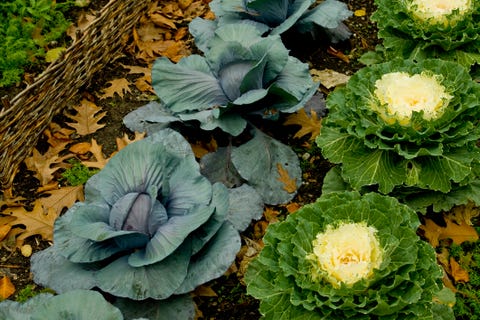What Is A Cover Crop In Gardening

Johner Images Getty Images
While your garden is overflowing with warm weather crops such as tomatoes and zucchini, you're probably not thinking about fall gardening. But actually, mid-summer is the perfect time to get your second round of veggies in the ground for a fall harvest. Fall vegetable gardens can be as prolific as those planted in spring and early summer. In a hot climate, there's time for a second crop of heat lovers such as beans. In cooler climates, many short-season crops, such as radishes, broccoli, and most types of greens, can be planted in mid to late summer for autumn harvests. And if you only have a balcony or deck, some veggies, such as lettuce or Swiss chard, can be grown in pots and window boxes. Combine them with fall flowers such as pansies and chrysanthemums for a pretty, edible container mix.
Here's what you need to know about how to plant a fall garden. Grab your best garden shoes and gardening gloves and start digging!
Don't wait too late.
The biggest mistake gardeners make is waiting too long to plant autumn crops. It may seem counter-intuitive to be sowing seeds (it's tough to find transplants this time of year) in the heat of summer, but your plants need enough time to mature before a frost. Read the packages to learn "days to maturity," which tells you how long you need to grow specific crops. Then check with your local university co-op extension service (find yours here) to find the average first frost date for your area. Count backwards from that date to figure out the latest possible day you can plant. For example, if your average first frost is October 15, and you want to plant lettuce, many mature in 30 days so the latest date for planting is September 15. Remember, frost dates are averages; sometimes, it's earlier or later than you expect. Nature likes to keep us on our toes!
Pull out faded summer crops.
If everything is healthy and producing in your garden, leave it be. But chances are some vegetables are past their peak. If your tomatoes are down to a few brown leaves and flowers but no maturing fruit, pull them out (pick any green tomatoes and let them ripen off-vine). Summer squash probably is winding down, too. Also, take out anything that's been struggling all season from bugs or disease; it's not going to get any better! Leave cool-season crops, such as broccoli, cabbage, and cauliflower, in place to finish maturing.
Plant fast-maturing crops.
Super-quick crops you can plant from seed include beets, turnips, and radishes, which are ready in as little as 25 days, and lettuce, which is ready in about a month. Other fast-growing greens include spinach, Swiss chard, mustard greens, collards, and kale. In fact, most types of collards and kale last until a hard freeze. Some kale varieties even survive winter and green up again next spring, so don't be too eager to yank your plants out at the end of the growing season when you're doing fall clean-up.

photosoul Getty Images
You still need to water and weed your fall garden.
Autumn has plenty of hot, dry days, so make sure you're watering if you haven't had rain for a week or so. Both seeds and transplants need steady moisture to help them establish. Greens especially prefer to be kept moist before and after germination. Don't slack off on weeding either because weeds compete for moisture and nutrients with the plants you do want. Bottom line: Yank weeds as you soon as see 'em so they don't get out of control.
Get a head start on next spring.
Some crops, such as garlic, must be planted now for harvest next spring and summer. Hardneck garlic grows long stems or scapes in the spring, which you also can harvest before the bulbs are ready in mid-summer. Softneck types are more suited to warm climates. Either way, separate the cloves and plant pointy-side up about 6 inches apart and a few inches deep; they may sprout but the crop won't be ready until next spring. Or plant perennial herbs such as thyme, chives, sage, and oregano, which will come back year after year.

Allkindza Getty Images
Add some compost.
Fall is a great time to topdress your garden with a layer of healthy compost. Remember that compost won't provide all the nutrients your garden needs, but it does improve soil structure to increase its water-holding ability and adds beneficial microorganisms to your garden. And if you haven't started a compost bin, start a pile behind your shed, DIY a simple bin, or pick one up at the hardware store. There's no sense wasting all those precious garden and kitchen scraps when you could be making compost for free.
Jot down a few garden notes.
Scribble down a few comments about what you planted and when, as well what did well and what was lackluster. It's super-helpful so you'll remember what you absolutely want to plant again and what wasn't worth your time. You also can tape seed labels and plant tags inside the notebook so you'll have this information handy when it's time to plant again next spring.
Tools to Plant Your Fall Garden
Arricca Elin Sansone Arricca SanSone has written about health and lifestyle topics for Prevention, Country Living, Woman's Day, and more.
This content is created and maintained by a third party, and imported onto this page to help users provide their email addresses. You may be able to find more information about this and similar content at piano.io
What Is A Cover Crop In Gardening
Source: https://www.countryliving.com/gardening/garden-ideas/a33754584/how-to-plant-fall-garden/
Posted by: gentilelovent.blogspot.com

0 Response to "What Is A Cover Crop In Gardening"
Post a Comment